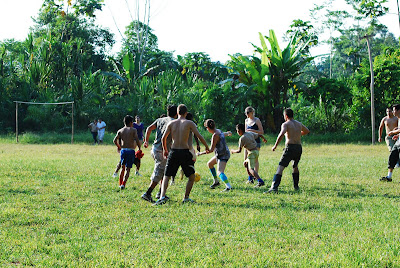Today was mostly devoted to the students at Yachana high school. After breakfast, we gathered some of our better Spanish speaking students and hiked the muddy trail back to the school. They were just finishing up an English lesson when we joined the group. There were 23 seniors in the class, all but 5 or 6 of whom were guys. Students at the school came from surrounding communities of different ethnic groups and seemed excited to be at one of the only schools of any quality in the area. Parents pay 200 dollars for their kids to attend, which is about half the average yearly income for most families in the area. Those that show promise, but who can't afford the fee are eligible for a full ride scholarship. The general atmosphere was of an eagerness to learn and we were greeted with enthusiasm by the students. We split the group into three workshop groups. Jeff talked to students about the idea of classification, and students discussed the animals they were familiar with in the forest and how they were related taxonomically. Jay had an interesting discussion about ecological footprints, the impacts of the American way of life on the planet, and the importance of conserving traditional cultures. Students seemed to really identify with the topics brought up in this session. For my group, I wanted to give them some practical guiding tips, as many of the students expressed an interest in becoming guides. We talked about important field marks for birds and how to explain the marks in English. I also encouraged them to learn as much as they could about the different species, such as behavior, foraging strategies, nesting, as well as interesting cultural connections with the birds. Finally, I encouraged the students to make things fun by imitating bird calls through whistles or other means, which can also be effective at bringing birds closer in to the group. Students worked in small groups to present a bird of their choosing, using as much English as possible.
Monique and Paula with students
From the exercise, I learned a few cool cultural things. According to some cultures, the White-throated Toucan is a bringer of rain. It makes a repeated whistling sound, which can be translated as hace sol sol sol. The toucan is complaining about the heat and calling for rain; after two days of calling, the rain will come. Interestingly enough, we heard the bird calling at the Yachana preserve the day before, and last night it rained for the first time since we have been here!
After a quick break for lunch and a siesta, we all headed back to the school for some friendly games with the students. I got caught up along the way photographing some Yellow-rumped Caciques in their colony and when I got to the school, the students were all playing a soccer match. Having played in high school, I jumped at the chance to play again and had a blast, although I am a little afraid of how sore my legs will be in the morning.

 After dinner, we headed out into the forest for another mind blowing night hike. With the rain last night, the diversity of herps and inverts was even more incredible than our previous night hike. Highlights for me included a bird-eating tarantula bigger than my hand, a mantis, whose body was flattened out to look exactly like a leaf, and a horned hemipteran with yellow wings.
After dinner, we headed out into the forest for another mind blowing night hike. With the rain last night, the diversity of herps and inverts was even more incredible than our previous night hike. Highlights for me included a bird-eating tarantula bigger than my hand, a mantis, whose body was flattened out to look exactly like a leaf, and a horned hemipteran with yellow wings.
Bird-eating Tarantula
Mantis
Hemipteran

Walking Stick herbivory
We also saw a beautiful poison dart frog.
Night Lizard












thanks for the ideas and information you provide, it really helped me in doing my job.
ReplyDelete